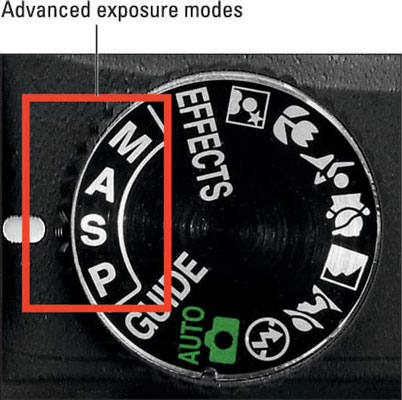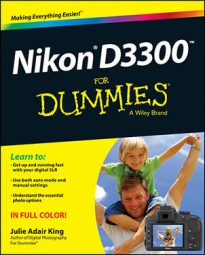In the fully automatic exposure modes on the Nikon D3300, you have little control over exposure. You may be able to choose from one or two Flash modes, and you can adjust ISO in the Scene modes and in all Effects modes except Night Vision and Easy Panorama.
But to gain full control over exposure, set the Mode dial to one of the advanced modes highlighted in this figure: P, S, A, or M. You also need to use these modes to take advantage of many other camera features, including some of its color and autofocus options.

The P, S, A, and M modes are critical to your control over exposure, so some additional information here. First, a recap of how the four modes differ:
P ( programmed autoexposure): The camera selects both aperture and shutter speed to deliver a good exposure at the current ISO setting. But you can choose from different combinations of the two for creative flexibility, which is why the official name of this mode is flexible programmed autoexposure.
S (shutter-priority autoexposure): You set the shutter speed, and the camera chooses the aperture setting that produces a good exposure at that shutter speed and the current ISO setting.
A (aperture-priority autoexposure): The opposite of shutter-priority autoexposure, this mode asks you to select the aperture setting. The camera then selects the appropriate shutter speed — again, based on the selected ISO setting.
M (manual exposure): In this mode, you specify both shutter speed and aperture.
To sum up, the first three modes are semiautomatic modes that are designed to offer exposure assistance while still providing you with some creative control.
Note one important point about P, S, and A modes, however: In extreme lighting conditions, the camera may not be able to select settings that will produce a good exposure, and it doesn’t stop you from taking a poorly exposed photo. You may be able to solve the problem by using features designed to modify autoexposure results, such as Exposure Compensation or by adding flash, but you get no guarantees.
Manual mode puts all exposure control in your hands. If you’re a longtime photographer who comes from the days when manual exposure was the only game in town, you may prefer to stick with this mode. If it ain’t broke, don’t fix it, as they say.
And in some ways, manual mode is simpler than the semiautomatic modes — if you’re not happy with the exposure, you just change the aperture, shutter speed, or ISO setting and shoot again. You don’t have to fiddle with features that enable you to modify your autoexposure results.
But even when you use the M exposure mode, you’re never really flying without a net: The camera assists you by displaying the exposure meter.

